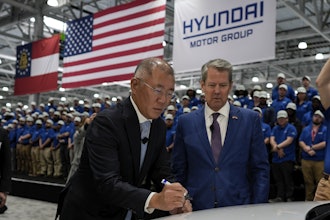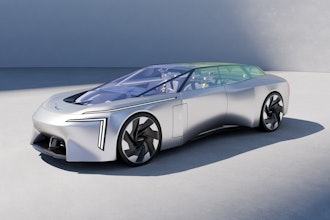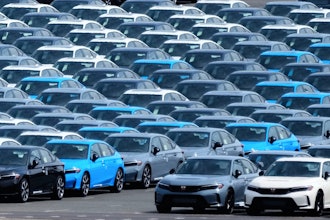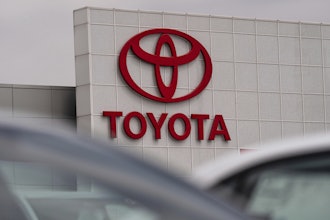
DETROIT (AP) — Global automakers and tech companies are stepping up the pace when it comes to building factories and prepare for what many believe will be a fast-moving transition from internal combustion engines to electric vehicles.
On Monday, Toyota, Stellantis, Foxconn, Ford and Volvo all made announcements about electric vehicle component or assembly plants, or plans to raise capital to fund the transition. The moves come on top of previous plans from Ford and General Motors to build five U.S. battery factories in anticipation of the shift to electric power.
The moves are ahead of demand at the moment, but forecasters predict that the share of electric vehicles will rise dramatically as more battery-electric models are rolled out as governments increase requirements for zero-emissions vehicles to fight climate change.
At present, only about 4.8% of the roughly 80 million new vehicles sold globally run solely on electricity, according to LMC Automotive.
But the consulting firm Alix Partners predicts that will rise to 11% in 2025 and 24% in 2030. If plug-in gas-electric hybrids, which can travel short distances solely on electricity, are included, that figure rises to 28% in 10 years.
Simultaneously, Alix Partners predicts that global sales of gas- and diesel-powered vehicles will fall from the current 89% to around 39% by 2030. Gas-electric hybrids, which run on gasoline and electricity at the same time, rise from 7% currently to 33% in 2030.
“All of us are trying to get a fix on how customers will accept electric vehicles,” Chris Reynolds, chief administrative officer for Toyota in North America, said in an interview with The Associated Press. “We don’t know for sure, but we have to be ready.”
Toyota said it plans to build a new $1.29 billion factory in the U.S. to manufacture batteries for hybrid and fully electric vehicles. The location wasn't announced, but the company said it eventually will employ 1,750 people and start making batteries in 2025, gradually expanding through 2031.
The plant is part of $3.4 billion that Toyota plans to spend in the U.S. on automotive batteries during the next decade. It didn't detail where the remaining $2.1 billion would be spent, but part of that likely will go for another battery factory.
Stellantis, formerly Fiat Chrysler, and LG Energy Solution said Monday that they plan to build a battery manufacturing facility to help the automaker get 40% of its U.S. sales from vehicles that run at least partly on electricity by 2030. They didn't say where the plant would be.
Also Monday, the Taiwanese company that makes smartphones for Apple and others, Foxconn Technology Group, said it would produce electric cars and buses for auto brands in China, North America, Europe and other markets.
Volvo Cars on Monday unveiled more details of its initial public offering that will fund its ambitious plan to transform into an all-electric vehicle company by 2030. The Swedish auto brand, owned by Chinese carmaker Geely, said the IPO would value the company at 163-200 billion kronor ($18.8-$23 billion) when shares start trading Oct. 28.
And Ford Motor Co. announced that it will turn a transmission factory in northwest England into a plant that will make electric power units for cars and trucks sold throughout Europe.
Most of the announcements lacked specifics such as locations, and some didn't say how many jobs would be created.
Jeff Schuster, president of global vehicle forecasting for LMC Automotive, said that's because it's “in vogue” for automakers to make such announcements, which are well-received by investors. But he said the plants will be necessary, especially in the U.S., where battery manufacturing capacity was lagging Europe and China.
“Behind the scenes this has been building as we look at moving to electric vehicle technology globally," he said. “This is the foundation. You need the batteries before you can get there.”
The moves come just after Ford and General Motors recently announced large investments in U.S. battery factories. GM plans to build battery plants in Ohio and Tennessee, while Ford has plans for plants in Tennessee and Kentucky.
Toyota will form a new company to run its new U.S. battery plant with Toyota Tsusho, a subsidiary that now makes an array of parts for the automaker. The company also will help Toyota expand its U.S. supply chain, as well as increase its knowledge of lithium-ion auto batteries, Toyota said Monday.
The new plant would likely be near one of the company's U.S. assembly plants in Missouri, Kentucky, Indiana, Alabama or Texas.
Toyota plans to sell 2 million zero emission hydrogen and battery electric vehicles worldwide per year by 2030. In the U.S., Toyota plans to sell 1.5 million to 1.8 million vehicles by 2030 in the U.S. that are at least partially electrified.
Reynolds said no one can predict exactly how fast the shift to battery power will happen, but he said a transition to gas-electric hybrids happened faster than Toyota anticipated when it introduced the Prius in the late 1990s. He sees hybrid and plug-in hybrids as a bridge between full internal combustion engines and battery-electric vehicles.
Now in the U.S., Toyota offers hydrogen vehicles, hybrids and plug-in hybrid powertrains. Toyota says vehicles that operate at least partially on electricity now account for about a quarter of its U.S. sales, and it plans for that to rise to nearly 70% by 2030.
The company says it will have 15 battery electric vehicles for sale globally by 2025.






















